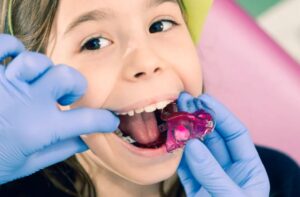Not long ago, Emma’s mom posted a message in our parenting group:
"My daughter just got her braces a few days ago. She says brushing hurts. When I try to help, she complains I’m brushing too hard. But when she brushes on her own, food is still stuck in her teeth. What should I do?"
This kind of frustration is something many parents face when their child starts orthodontic treatment. Once the braces are on, brushing gets trickier—and more important than ever. Poor brushing habits can lead to cavities, swollen gums, and even delays in the whole treatment.
So, how should kids brush their teeth after getting braces?
1. Start with the Right Tools
Regular toothbrushes often can't reach all the tight spots around brackets and wires. To make brushing more effective, consider getting:
- Orthodontic toothbrush: These have small heads and V-shaped bristles, designed for cleaning around braces.
- Interdental brush: These tiny brushes are great for getting between brackets and under wires.
- Water flosser: A gentle stream of water can flush out stuck food—especially helpful before bedtime.
- Fluoride toothpaste: Helps strengthen teeth and prevent cavities.
These tools make brushing less frustrating and much more effective.
2. Create a Simple Brushing Routine
Try using the “3-3-3 Rule” to help your child build a healthy habit:
- Brush 3 times a day: After breakfast, after lunch, and before bed.
- Brush for 3 full minutes each time. Set a timer if needed!
- Follow 3 steps:
- Use an orthodontic toothbrush to clean around brackets and the surface of each tooth.
- Use an interdental brush to reach the tight areas between wires and teeth.
- Finish with a water flosser to rinse away anything left behind.
Make sure your child focuses on easy-to-miss areas like the front teeth, back molars, and the gumline.
3. Parental Supervision Really Helps
Even if your child is around 10 or older and can brush independently, they may still need help at first. Their technique might be too quick or incomplete.
For the first 2–3 weeks after getting braces, try brushing with them or watching closely to guide them. You can even use a mirror or take a photo of their teeth to show them what’s clean—and what’s not. This helps them learn and take responsibility over time.
4. Diet Affects Cleanliness Too
Sticky and sugary foods like gummies, caramel, popcorn, and nuts are not only bad for braces—they're also very hard to clean off. Try to avoid these snacks while your child is wearing braces.
Instead, offer softer foods like fruits, yogurt, steamed veggies, and other fiber-rich options. Also, remind them to drink plenty of water and skip sugary drinks when possible.
5. Don’t Skip Dental Visit
Even with perfect brushing at home, plaque can still build up around braces. That’s why dentists recommend a professional cleaning every 3–6 months during orthodontic treatment.
Regular checkups also give the orthodontist a chance to spot problems early—like loose brackets or signs of poor hygiene.
In Summary
Wearing braces is a long-term journey. Good brushing habits play a huge role in how healthy your child’s teeth stay—and how successful the treatment is.
Brushing may seem like a small task, but it makes a big difference in the outcome. As parents, your encouragement, supervision, and support can set your child up for a lifetime of healthy smiles.













